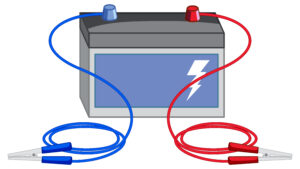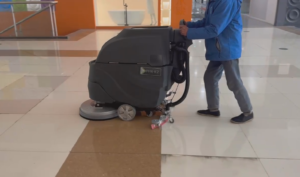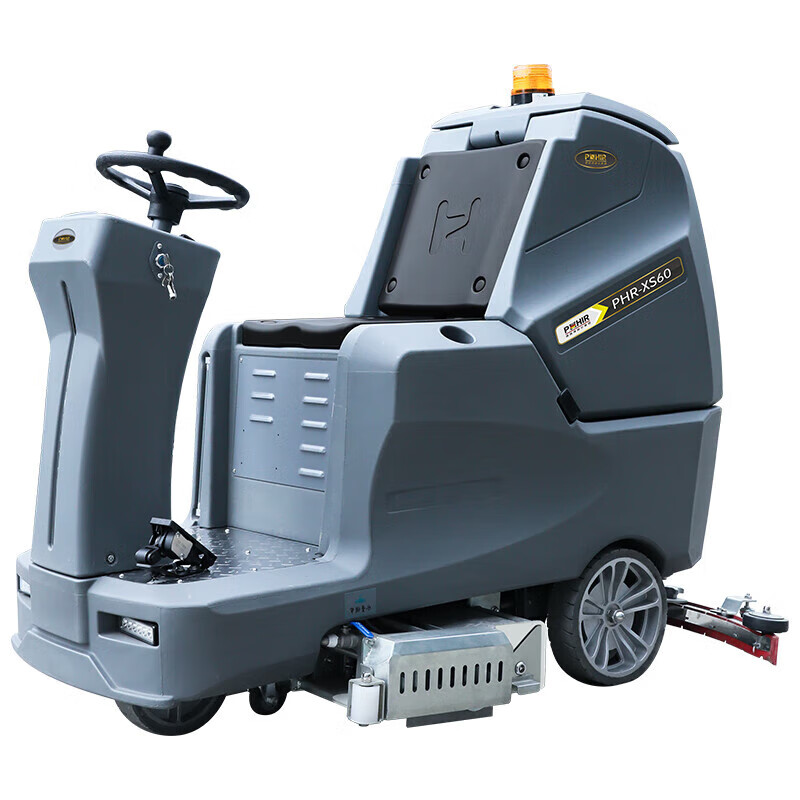Introduction
Unexpected breakdowns and costly repairs often stem from overlooked maintenance and improper use of floor scrubbers. For business owners and maintenance teams, extending floor scrubber lifespan isn’t just about saving money—it’s about keeping cleaning operations smooth and reliable.
By focusing on routine maintenance, battery care, and wisely choosing cleaning pads and chemicals suited to your floors, you can prevent wear and tear that shortens machine life. Drawing on experience supporting cleaning solutions like those from Pohir Group, this guide shares practical tips to reduce downtime and keep your floor scrubber “rocking” for years to come.
Prioritize Routine Maintenance with a Comprehensive Checklist
Keeping your floor scrubber in tip-top shape starts with a solid routine. When we focus on scheduled maintenance, we can really extend floor scrubber lifespan and avoid pricey downtime. Regular checkups and cleaning keep the components humming and reduce machine wear and tear. With the right approach, your scrubber lasts much longer and performs better.
Daily routines are the frontline defense. Start by inspecting brushes for fraying or damage because worn brushes don’t clean effectively and can harm floors. Squeegees should be wiped and checked for cracks to avoid streaks or water damage. Filters need clearing out daily too, or you risk clogging that lowers machine efficiency. These simple steps each day set the stage for a longer-lasting scrubber.
On a weekly and monthly basis, deeper maintenance tasks help catch small problems early. Weekly, give brushes a thorough wash and inspect the squeegee’s blade sharpness and alignment. Filters might need a complete wash or replacement depending on usage. Monthly, check the battery and electrical connections, lubricate moving parts, and test machine performance. Documenting these tasks in a checklist keeps everything on track and ensures no step is missed.
Many businesses slip up by neglecting these maintenance schedules or skipping inspections. Skipping brush replacement or ignoring worn squeegees causes unnecessary wear on the entire system. Using wrong cleaning pads or chemicals not suited for specific floor types also accelerates machine breakdown. Picking the right pads, brushes, and cleaning agents designed for your floor type is a hidden game-changer for extending floor scrubber lifespan. It avoids damage and boosts efficiency.
“Regularly following a comprehensive maintenance checklist and tailoring cleaning supplies to your floor type are key to reducing repair costs and maximizing scrubber lifespan.”
Besides boosting reliability, this routine maintenance schedule cuts downtime dramatically—no more unexpected halts mid-shift. It also slashes repair bills and extends the scrubber’s life, creating better return on investment. At Pohir Group, we offer tailored maintenance guidance matching machine types and usage conditions that fit your needs. That way, you get the most from every sweep and scrub.
Floor Scrubber Maintenance Tasks and Their Impact
| Maintenance Task | Frequency | Measurement Method | Impact on Lifespan | Industry Benchmark |
|---|---|---|---|---|
| Brush inspection and cleaning | Daily | Visual check and physical wear test | Prevents uneven wear and floor damage | Replace brushes every 500 operational hours |
| Squeegee blade check | Daily | Visual and water pickup efficiency test | Avoids streaking and floor water damage | Replace blades every 3 months or when worn |
| Filter cleaning/replacement | Daily/Weekly | Airflow obstruction evaluation and pressure drop | Maintains suction, reduces motor strain | Clean weekly; replace monthly or as needed |
| Battery and electrical check | Monthly | Voltage and connection tightness tests | Prevents power loss and component damage | Perform detailed checks every 30 days |
| Cleaning pad and chemical selection | Reviewed quarterly | Floor type match and chemical compatibility test | Reduces wear; improves cleaning efficiency | Use manufacturer recommended supplies |
We emphasize that following these maintenance tasks regularly and selecting the right cleaning materials help keep your floor scrubbers running smoothly. Adjusting based on your machine model and flooring conditions is crucial. That’s how you truly extend floor scrubber lifespan, keep operations smooth, and prevent common machine wear and tear issues.

Master Proper Battery Care and Storage for Lasting Performance
Taking care of your floor scrubber batteries is a big part of how we extend floor scrubber lifespan and keep machines running strong. Different types of batteries such as wet flooded, gel, lead-acid, and lithium each have unique needs, making floor scrubber battery care a must-learn skill. When handled right, batteries deliver steady power and reduce costly replacements.
Wet flooded batteries require regular water top-ups to avoid damage, while gel and lead-acid types need less watering but still benefit from neat charging routines. Lithium batteries are lighter and last longer, though they demand precise charging and temperature management. Understanding your battery type helps choose the correct battery charging and storage techniques to keep it healthy.
Charging your batteries properly means avoiding deep discharges and preventing overcharging. The best maintenance tip is to charge batteries fully but not let them sit at full charge too long. Frequent partial charges can actually extend battery life better than waiting for complete drain. Storing batteries in cool, stable temperatures with proper ventilation avoids heat damage, which is a sneaky battery killer.
Routine cleaning is often overlooked but just as essential. Battery terminals can corrode, causing poor power flow and erratic machine behavior. Wiping terminals clean and applying anti-corrosion spray prevents this. Combined with secure, tight connections, this simple step boosts reliability and uptime.
“Using correct battery types and following smart charging and storage routines directly improve machine uptime and extend floor scrubber lifespan.”
Choosing batteries and chargers compatible with Pohir Group scrubbers also matters. We recommend selecting parts that meet our specs to ensure smooth integration and optimal performance. This approach lowers replacement frequency and keeps your cleaning operations running without surprises.
Battery Types and Maintenance Best Practices
| Battery Type | Charging Requirements | Storage Conditions | Maintenance Tasks | Typical Lifespan |
|---|---|---|---|---|
| Wet Flooded | Regular full charges, avoid deep discharge | Cool, dry place; water top-up needed | Check water levels daily, clean terminals | 2-3 years |
| Gel | Use gel-compatible charger, avoid overcharge | Stable cool temp, avoid freezing | Terminal cleaning monthly, check charge | 3-4 years |
| Lead-acid | Controlled charging, no water needed | Cool, ventilated area | Clean terminals, inspect connections | 3-5 years |
| Lithium | Precision chargers, avoid high temp | Climate controlled; avoid overheating | Periodic firmware update, clean terminals | 5-7 years |
| Best Charging Practice | Partial charges better than full drains | Maintain stable temp 50-77°F (10-25°C) | Use recommended chargers for longevity | Varies by battery type |
Remember, smart battery care is not just about the battery itself but also how it complements the rest of your machine maintenance routine. Matching cleaning pads and chemicals to your floors helps reduce strain on motors and batteries alike. This holistic approach gets the most out of your investment.

Select the Right Cleaning Pads, Brushes, and Chemicals Tailored to Floor Types
Choosing the right cleaning pads, brushes, and chemicals is a serious key to extend floor scrubber lifespan and protect your flooring investment. Different floor materials need specific pads and brushes to clean effectively without causing damage. We’ve seen too many folks lose time and money by using the wrong consumables.
Matching cleaning pads to floor type is a straightforward but crucial step. Soft floors like vinyl or laminate require non-abrasive pads like white or beige, whereas hard floors such as concrete or tile can handle heavier-duty pads like red or green. Brushes, too, differ in stiffness and bristle type, impacting how gently or aggressively the floor gets scrubbed. Using brushes not meant for your floor leads to scratches or premature brush wear, which shortens scrubber life.
The chemical agents you use matter just as much. Harsh chemicals or those not made for specific floor finishes can cause corrosion on your scrubber’s metal parts and damage flooring surfaces. Safe, manufacturer-recommended cleaning solutions reduce these risks and keep both machines and floors happy. It’s also smart to think about environmental impact by choosing biodegradable and low-VOC products when possible – better for your crew and planet.
Ignoring these essentials leads to faster machine wear and more frequent repairs. Integrating smart floor scrubber cleaning tips into daily operations saves downtime and maintenance costs. Plus, it keeps your floors radiant and extending your scrubber’s lifespan.
“Using cleaning pads, brushes, and chemicals tailored to your floor type minimizes damage and maximizes your scrubber’s working life.”
Below is a detailed table outlining common floor types, compatible pads, brushes, chemicals, and some environmental safety notes to guide your choices effectively.
Optimizing Cleaning Supplies for Different Floor Types
| Floor Type | Recommended Pads | Recommended Brushes | Safe Cleaning Chemicals | Environmental & Safety Notes |
|---|---|---|---|---|
| Vinyl & Laminate | White, Beige (Non-abrasive) | Soft nylon bristle brushes | Neutral pH cleaners, biodegradable | Low VOC, non-toxic to protect indoor air quality |
| Concrete & Stone | Red, Green (Medium to heavy duty) | Stiff synthetic brushes | pH-neutral or mild alkaline cleaners | Use eco-friendly, avoid acids that damage stone |
| Wood & Parquet | Beige or white pads (Soft) | Soft natural fiber brushes | Wood-safe, neutral pH cleaners | Avoid excess water and harsh chemicals to prevent warping |
| Terrazzo & Marble | White or beige pads | Soft nylon brushes | Neutral pH, stone-specific cleaners | Prevent acid exposure to protect shine and surface |
| Carpeted Areas (Spot Cleaning) | Specialty pads designed for carpet | Microfiber brushes or carpet cleaning heads | Approved carpet detergents | Ensure chemical rinse-off to avoid residue buildup |
Choosing the right cleaning supplies isn’t just about avoiding damage; it’s about preserving your machine’s lifespan and maintaining high cleaning standards. At Pohir Group, we recommend always matching your pads, brushes, and chemicals to your floor type for top results and machine longevity. This approach is a real game-changer for efficient, safe, and cost-effective cleaning.

Balance Frequency and Intensity of Use to Prevent Premature Wear
Knowing how often and how hard to run your floor scrubber plays a crucial role in extending floor scrubber lifespan. Using machines too much or pushing them past their limits increases machine wear and tear, which drives up maintenance costs and cuts service intervals short. Striking a balance based on your facility’s needs helps keep scrubbers working longer and more reliably.
Consider your facility type when deciding how frequently to operate the scrubber. High-traffic commercial areas may require daily cleaning, while warehouses with less foot traffic could manage with fewer cycles weekly. Tailoring cleaning frequency keeps machines from unnecessary strain and avoids premature parts breakdown.
Excessive pressure during operation is another common offender. Applying too much force while scrubbing not only wears brushes and pads faster but also strains motors and structural components. It’s tempting to “go hard or go home,” but gentle consistent use can save you headaches down the road. Monitoring pressure and teaching operators proper techniques minimize this risk.
Early identification of machine wear unlocks timely fixes before costly failures occur. Indicators like unusual noises, decreased performance, or longer cleaning times signal the need for inspection. Regular floor scrubber maintenance tied to usage patterns helps catch issues early, preventing downtime and prolonging scrubber life.
“Optimizing use frequency and pressure lowers repair needs, extends service intervals, and maximizes return on investment for floor scrubbers.”
Below is a data table showing typical maintenance impact related to usage frequency and operational intensity across common facility types.
Impact of Usage Patterns on Floor Scrubber Maintenance
| Facility Type | Recommended Use Frequency | Operational Intensity | Maintenance Frequency | Average Component Wear Rate |
|---|---|---|---|---|
| Retail Stores | Daily to 5 times/week | Moderate | Monthly | Low to Moderate |
| Warehouses | 2-3 times/week | Low to Moderate | Quarterly | Low |
| Healthcare Facilities | Daily | Moderate | Every 3-4 weeks | Moderate |
| Manufacturing Sites | Daily or multiple times/day | High | Weekly | High |
| Educational Institutions | 3-5 times/week | Moderate | Monthly | Low to Moderate |
Balancing how often and how intensely you use your floor scrubber, combined with attentive maintenance, makes a big difference in extending floor scrubber lifespan. At Pohir Group, we encourage customized cleaning schedules that fit your environment to save money and keep everything running smooth.

Ensure Spare Parts Availability and Leverage Manufacturer Support for Efficient Repairs
Keeping a steady stock of key spare parts is essential to extend floor scrubber lifespan and minimize downtime. Pads, brushes, batteries, and filters are wear items that need timely replacement to avoid costly breakdowns. Having these parts readily available means you can fix issues quickly and keep machines running smoothly.
Building a reliable parts supply chain starts by knowing which components wear out fastest and impact your operations most. Monitor your machine usage and maintenance records to anticipate when replacements are needed. Partnering with trusted suppliers, especially your manufacturer, ensures authentic parts that fit perfectly and maintain machine performance.
At Pohir Group, we pride ourselves on offering full support, warranty services, and expert technical resources to help you get the most out of your scrubbers. Our team is ready to assist with troubleshooting, parts sourcing, and scheduled maintenance plans tailored to your usage patterns. This level of support reduces unexpected costs and keeps your cleaning operations on track.
Scheduling regular professional maintenance checks is another smart move. Experts can spot emerging issues and replace parts before they cause failure. Combining proactive maintenance with spare parts availability creates a seamless workflow that supports long-term machine health and operational efficiency.
“Prompt access to genuine spare parts and leveraging manufacturer support play a crucial role in reducing downtime and extending floor scrubber lifespan.”
The table below outlines essential spare parts, their average lifespan, and recommended stock levels based on usage to guide your supply planning.
Key Spare Parts Inventory and Management for Floor Scrubbers
| Spare Part | Average Lifespan (Operational Hours) | Recommended Stock Level | Impact on Machine Performance | Replacement Indicator |
|---|---|---|---|---|
| Cleaning Pads | 200-500 | 3-5 sets | Affects cleaning quality and floor protection | Visible wear, reduced cleaning efficacy |
| Brushes | 500-800 | 2-3 sets | Essential for scrubbing power and even floor coverage | Frayed bristles, uneven cleaning |
| Batteries | 2-5 years | 1-2 units | Determines machine uptime and power delivery | Reduced run time, charging difficulties |
| Filters | 1-3 months | 5-10 units | Maintains suction and prevents motor strain | Clogging, decreased suction power |
| Squeegees | 3-6 months | 2-4 units | Ensures effective water pickup and streak-free floors | Cracks, streaks, poor water removal |
By prioritizing spare parts availability and tapping into Pohir Group’s manufacturer support, you create a maintenance system that keeps your floor scrubbers in prime condition. This approach lowers repair delays, reduces unplanned downtime, and truly helps extend floor scrubber lifespan.

Conclusion
From my time working closely with floor scrubbers, I’ve learned that keeping these machines running smoothly is all about attention to detail and consistent care. Routine maintenance, smart battery habits, and picking the right cleaning supplies don’t just extend machine life—they make your daily cleaning grind way easier and more reliable.
I’ve seen firsthand how following a tailored upkeep plan and staying ahead of wear-and-tear helps avoid surprises and keeps operations “rocking”. It’s not just about fixing problems but preventing them, so your floor scrubber stays a trusted partner in your workspace.
Think of your scrubber like a hardworking teammate—it thrives on good care and the right support. Keep this mindset, and you’ll get solid performance and value over the long haul, turning maintenance from a chore into a smart strategy that really pays off.
FAQ
-
Q1: How can I extend the lifespan of my floor scrubber?
A1: To extend your floor scrubber’s lifespan, regularly inspect and clean battery terminals, hoses, and tanks. Choose the appropriate pads and brushes and maintain proper battery charging and storage.
-
Q2: What regular maintenance does a floor scrubber require?
A2: Routine floor scrubber maintenance includes checking and cleaning parts, following manufacturer guidelines, and ensuring pads and brushes are in good condition to prevent wear.
-
Q3: How does battery care affect a floor scrubber’s lifespan?
A3: Proper battery care, including following charging protocols, maintaining optimal temperatures, and regular cleaning, is crucial for enhancing the operational life of your floor scrubber.
-
Q4: What cleaning chemicals are safe for use with floor scrubbers?
A4: Use pH-neutral cleaning solutions that are specifically designed for floor scrubbers to avoid damaging the machine.
-
Q5: How often should I replace the brushes on my floor scrubber?
A5: Brushes should typically be replaced when the bristles become worn or start to lose their effectiveness, usually every 100–300 hours of use depending on floor type.
-
Q6: Does the frequency of use affect a floor scrubber’s lifespan?
A6: Yes, the frequency of use significantly impacts a floor scrubber’s lifespan; machines used daily in high-traffic areas will wear out faster than those used less frequently.
-
Q7: What signs indicate my floor scrubber needs maintenance?
A7: Signs include decreased cleaning efficiency, unusual noises, battery issues, or if water isn’t dispensed properly.
-
Q8: Can using the wrong pads damage my floor scrubber?
A8: Yes, using incorrect pads can lead to machine inefficiency and cause excessive wear on both the pads and the scrubber components.


